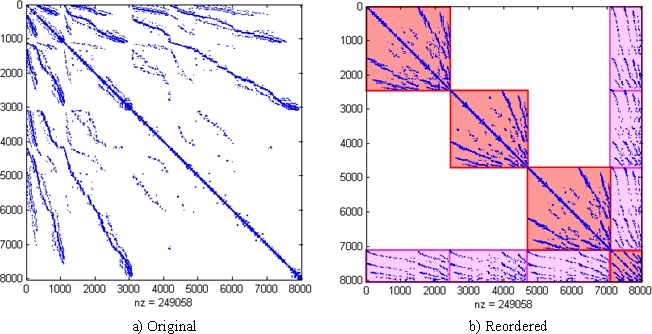
engineering & technology publications
ISSN 1759-3433
PROCEEDINGS OF THE FIFTH INTERNATIONAL CONFERENCE ON ENGINEERING COMPUTATIONAL TECHNOLOGY
A Domain Decomposition Iterative Solver based on a Hierarchical h-Adaptive Finite Element Code
1Research Centre on Vehicles Technology, Department of Mechanical and Materials Engineering,
2Multidisciplinar Mathematics Institute,
Polytechnic University of Valencia, Spain
The system matrix is symmetric and positive definite, therefore the
preconditioned conjugate gradient method (PCG) [2] is one of the most
efficient available iterative methods. One of the preferred preconditioners is the
incomplete cholesky factorization method (IC) [3]. This paper will consider a PCG
method using an IC over the original un-reordered stiffness matrix as a reference
method that will be compared to two different preconditioning strategies that make
use of the block structure. The first strategy, denoted by ![]() , consists of
computing the preconditioner using the main diagonal blocks of the reordered
matrix. The second strategy, denoted by K, consists of evaluating the preconditioner
using the whole reordered matrix.
, consists of
computing the preconditioner using the main diagonal blocks of the reordered
matrix. The second strategy, denoted by K, consists of evaluating the preconditioner
using the whole reordered matrix.
Further numerical tests were run in order to check the effect that additional domain decompositions into the original subdomains would produce. The Matlab's command SYMAMD [4] was used to further transform the diagonal blocks into matrices with an arrowhead-like structure similar to those that would be directly obtained using nested domain decomposition into each of the original subdomains.
Memory requirements, associated with fill-in coefficients, and execution times have
been considerably reduced with the proposed strategies. This memory requirement
reduction allows bigger problems to be solved. The memory requirement reduction
allows for the use of the K+additional Symamd reorder strategy even for small
values of the threshold parameter ![]() considered in the evaluation of the
preconditioner. This strategy has shown the better performance in the more refined
meshes in all cases. This suggests the use of this strategy for finer meshes. The
numerical tests presented in this paper show the importance of the use of further
domain decompositions into the original subdomains.
considered in the evaluation of the
preconditioner. This strategy has shown the better performance in the more refined
meshes in all cases. This suggests the use of this strategy for finer meshes. The
numerical tests presented in this paper show the importance of the use of further
domain decompositions into the original subdomains.
- 1
- J.J. Ródenas, J.E. Tarancón, J. Albelda, A. Roda, J. Fuenmayor, "Hierarquical properties in elements obtained by subdivision: a hierarquical h-adaptivity program", in Adaptive Modeling and Simulation 2005. P. Díez and N.E. Wiberg, (Editors), CIMNE, Sept. 2005.
- 2
- M.R. Hestenes, E.L.Stiefel. "Methods of conjugate gradients for solving linear systems", Journal of Research of the National Bureau of Standards., Section B, 49, 409-436, 1952.
- 3
- Y. Saad. "ILUT: a dual threshold incomplete ILU factorization", Numerical Linear Algebra with Applications, 1, 387?402, 1994. doi:10.1002/nla.1680010405
- 4
- MATLAB, http://www.mathworks.com
purchase the full-text of this paper (price £20)
go to the previous paper
go to the next paper
return to the table of contents
return to the book description
purchase this book (price £105 +P&P)
